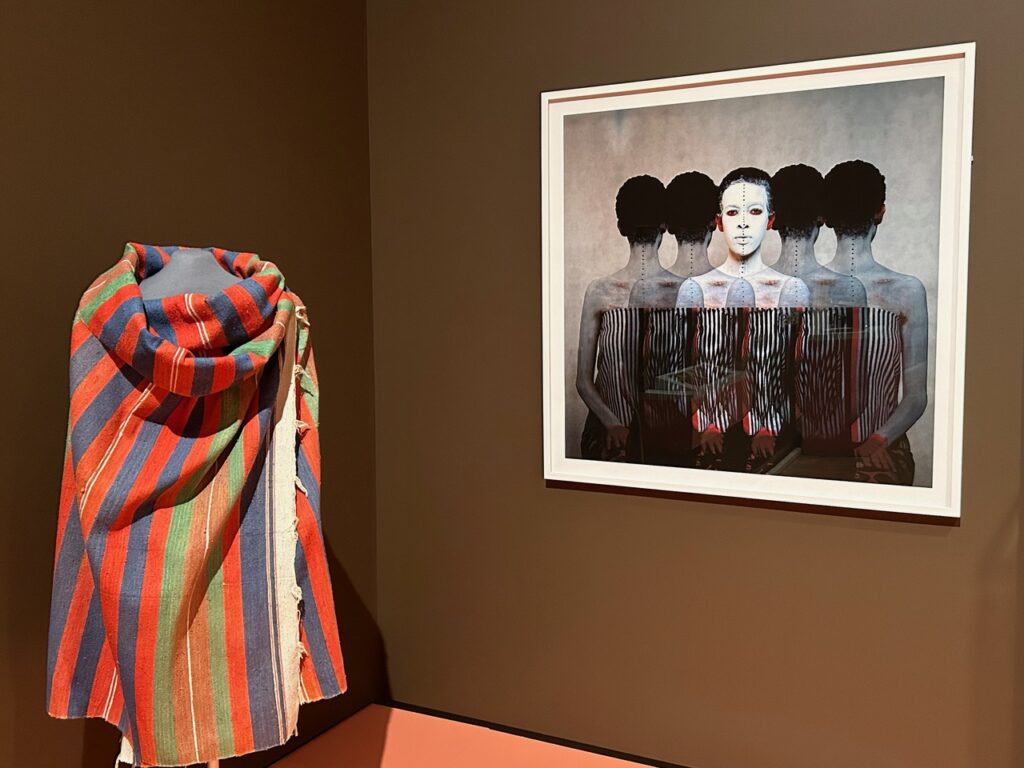By DAVID DUPONT
BG Independent News
The Toledo Museum of Art’s new exhibit “Ethiopia at the Crossroads” sets the visitor adrift in time.
The art in the exhibit spans almost a millennium, and represents a tradition that date to Biblical times.
The exhibit opened last week and will be on view through Nov. 10.

Conceiving King Manilak I,” & “Mother of Menelik” by Yatreda.
Most works on display come from the long period of the nation’s Solomonic dynasty that begins with Ethiopia Queen Makadda, known in the West as the Queen of Sheba, traveling to meet King Solomon. Their union conceived of Manilak, whose line of kings lasted into the 20th Century until the assassination of Emperor Haile Selassie. During that time, the country was never colonized.

Sacred illustrated texts, weavings, baskets, and icons form the backbone of the exhibit. But the work does not end there. Also featured is contemporary work by Ethiopians and the Ethiopian diaspora. These works are intermingled throughout.
A brass crown from the 18th century shares a display case with a brass sculpture by Helina Metaferia inspired by traditional Ethiopian crowns.

Metaferia, the child of Ethiopian immigrants, was born in Washington D.C. in 1983, is represented by two collages. She creates headdresses modeled after those worn by empresses from parts of photographs from the racial reckoning in the 1960s and 1970s. Each headdress rests crown-like on the head of an African-American woman. In one case, though not noted, the model certainly appears to be Nina Simone.

Another contemporary work by fabric artist Faith Ringgold uses fabrics from Ethiopia to create a homage “Lucy: The 3.5 Million Year Old Lady,” Lucy being the English name for the ancient remains discovered in Ethiopia. The Ethiopians call this eldest of human ancestors Dinkinesh or “you are marvelous.”
As with other recent major exhibits, a signature piece from the Toledo Museum’s own collection occupies a place of pride. In this instance it is Elias Sime’s “Tightrope, Zooming In,” made from reclaimed electronic parts, which usually is at home in Gallery 1 off the Libbey Court.

Toledo curator Sophie Ong said having these familiar works placed in a new context helps visitors see them anew and gain appreciation for them.
“Ethiopia at the Crossroads” has its roots in the museum’s restoration of the Cloister. Ong said she reached out to others in the museum community for ideas about how to expand the global reach of the space.
That included purchasing a psalter — an illustrated prayer book — from Ethiopia to represent the intersection of Orthodox Christianity and Catholicism. This exhibit notes that in the 14th century Ethiopia began sending envoys to Europe.

Among those with whom Ong consulted was Christine Sciacca, now of the Walters Art Museum in Baltimore. She was already envisioning “Ethiopia at the Crossroads.”
The collaboration with Ong and the TMA was firmed up when she visited to attend the reopening of the Cloister.
The show originated in Baltimore.
The Baltimore-Washington D.C. metro area has more Ethiopians than anywhere other than Ethiopia itself.
Sciacca is the lead curator for the exhibit that was shown at the Walters and the Peabody Essex Museum in Salem, Massachusetts.
This is the first major exhibit focused on Ethiopia in 30 years, and the largest in 60 years, Museum Director Adam Levine said. It is not just beautiful, and relevant. “It is important.”
“This is an exhibition that brings global histories together,” Ong said. “It’s centered on Ethiopia but incorporates so many cultural communities, regions of the world.”
Ong also noted that the exhibit “shows the importance and relevance of historical objects today. Many of manuscripts are still being used and cherished.”

Visitors arrive at the Toledo Museum’s biggest addition to the show, the immersive digital artwork “House of Yatreda,” created by art collective Yatreda. The multi-image projections tell a fanciful story of an ancient queen.
This is based childhood stories director Kiya Tadele and other members of her far-flung family, with members in Ethiopia, Kenya, and Canada. With family and friends serving as models, the collective places themselves in the once & future story of their home country.
The digital nature of the piece and the related digital objects projects the nature of art into the future.
Members of the collective created “House of Yatreda” as part of the digital art residency in Toledo.
This is a reflection of the museum’s mission to put its mark on the art world.
Levine said the museum’s directors had approved a goal to organize or co-organize all its special exhibits by 2026. They have already achieved that.
“Producing scholarship is important,” he said. “By organizing these exhibits we promote our brand.”





